November 2007 – Catamaran Sailing Cruising in the Sea of Cortez
Thursday November 1, 2007
Today we motored over to east bight of East Bay. We didn’t go for a hike today but did go ashore to burn some garbage.
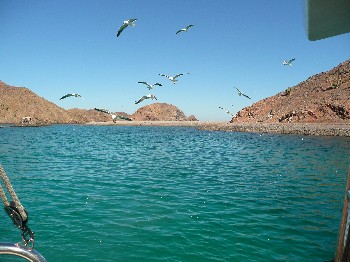
Sometimes the resident seagulls filled the air at our primary
night anchorage inside Refugio, squawking, moaning and
screeching. We have no idea what would set them off.
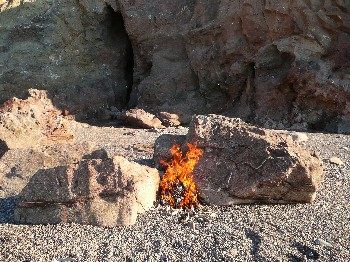
Burning garbage at our third day anchorage at Refugio.
Carllie: We have decided to stop dumping our garbage in receptacles on shore because the people just take it to some otherwise pretty mountain canyon and dump it. We are visitors, and we have to look after any garbage we create. So we toss compostable stuff and even remnants of cooked food into the water, unless we are in a tiny cove with little water movement; when we are in over 200 feet of water we throw overboard any tins, which we have punctured to be sure they sink (these will eventually rust and be absorbed by the sea); and we save plastics and paper for little bonfires on shore where appropriate. Thus, we are not carrying a lot of garbage around with us and what we are carrying does not smell. We have since learned from much more savvy long-term cruisers experienced in third world countries that it is far better to look after all of your own garbage. We agree with our friends’ analyses: If you dump your garbage in a city or town in Mexico, where is it going to go? Their municipalities certainly do not have money for costly garbage treatment centres, so they simply take it somewhere else (like a beautiful mountainside) and dump it. By disposing of our own garbage, we are doing the responsible and most ecologically friendly thing.
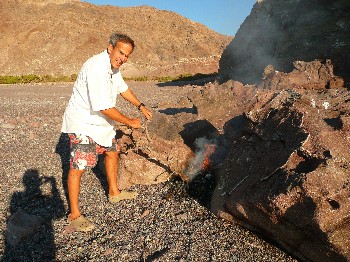
It was an effort to gather enough dry sticks
on land to start the fire.
Garett: At about 4 p.m. we motored the miles in the dinghy to Isla Granito so that I could try swimming with the baby sea lion pups. Carllie was not quite up to this yet so she stayed in the dinghy as spotter and chief photographer.
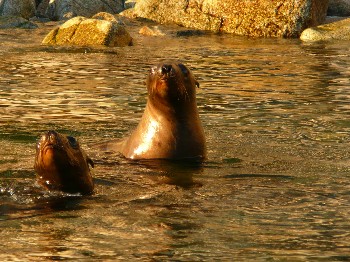
Curious sea lion pups check out Garett
as he swims in their pool.
They were very cautious with him,
and only got so close.
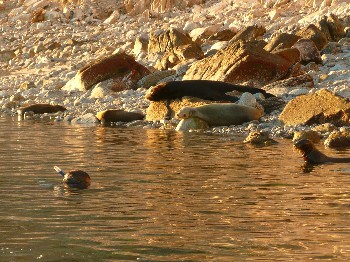
I was a little apprehensive, especially after my surprise encounter with one while snorkelling the other day. After anchoring the dinghy in about 10 feet of water I jumped in with my wetsuit and snorkeling gear. Within minutes the little pups swam up to me. They are so graceful in their element. It was quite an experience. Carllie was encouraged and decided that she would do it in a couple of days.
Carllie: It was so funny and enchanting watching these little pups swim around Garett, yet keep a little distance. They are so insatiably curious, much like the river otters we sometimes see in home waters. Eventually, they got closer and closer to Garett and often several little heads had poked up out of the water within a few feet of him. Garett stayed in the water about 20 minutes, while I just sat in the anchored dinghy with the camera, watching. It was very peaceful as there was no weather this day, no wind or waves, and of course the Refugio area is a very long way from any "civilization." The only civilization was that of the sea lions, and it was a very peaceful little village aside from the occasional honking statements of the adults, and the little honks, squeals and chirps from the pups. I soon felt at one with these creatures, though not to the point of exchanging a few words with a bull sea lion, and was now looking forward to swimming with them myself in a couple of days.
Friday November 2, 2007
Garett: We lingered in Mejia Cove this morning as there was enough south wind to keep the bugs at bay. I went for my daily fishing expedition to the point next to the channel about 75 yards away, where the water really rushes through during tidal changes. Sometimes at the point it was a little tricky getting back into the cove as the water was rushing out, so I had to swim close to the rocks.
Today I saw my fist golden grouper. What an incredible looking fish! In the underwater world here which is colored in muted greys, greens, and black, this beautiful fish really stands out. I could see him just at the periphery of my vision (about 30 feet) circling around. I eventually concluded that he stayed around one particular rock. In between glimpses of him I kept diving to the bottom at 10 to 15 feet and fishing for the more prolific and less wary leopard grouper and the Mexican hogfish.
Hogfish are very interesting. They are one of the bigger reef fish (2 feet long) on the average rocky shoreline. They have whispy small fins and dorsal fins as well as a vertical yellow stripe halfway on their green bodies, but their most distinguishing feature is their blunt head which makes them lock rather non-aerodynamic. I have tried to get one of these several times and even though I have fired my spear from point-blank range all I see is a puff of scales and they just swim away. I discussed this with some of my experienced spearfishing friends and found out that hogfish have an extremely thick layer of scales which makes them very difficult to spear. I was watching some of the usual hogfish when all of sudden the biggest fish (3 feet long) I had ever seen appeared. It looked like a hogfish with its unique head shape but this one had this broad 4 inch red vertical stripe in the middle. It may have been a parrot fish. I only saw him once from about 10 feet away but it was very impressive.
Back to the golden grouper. I saw the golden grouper hiding under the rock ledge where I had spied him previously. He was sitting there perfectly still, and I happened to be slowly moving in that direction at the time. I kept ever so slowly closing the distance until I was only 5 feet away. This was my chance! I let go with the spear…oh no.. just slightly high as he zipped away. Oh so close…I will just keep trying. It was a fun morning under water.
When the wind died at noon we were off to the West Bay again where I spent the afternoon replacing all the corroded electrical connections from the solar panel under the arch while Carllie continued working on her article.
Saturday November 3, 2007
Garett: I was up early and decided to try my spearfishing luck at the nearby point in the channel at 8 a.m..The current was not as strong as yesterday so it was much easier. I was really looking for the golden grouper. I did spot him once today but never got anywhere near as close as yesterday, though I did manage to spear one of the very common black fish (name unknown) that are everywhere. They do not make the best eating, but beggars cannot be choosy. My experienced friend Bill on Moon Hunter had advised me to develop the habit of counting when you free dive as this does two important things: 1) Allows you to keep track of your time under water,and 2) Keeps your mind working and analytical. At first it was very difficult to do with all the other things you do in a dive such as pressurizing your ears, lifting your leg, exhaling a little air into your mask at depths, etc. but now it is becoming part of the process. I was able to get my count up from 30 to 40 seconds on some dives which is a big improvement since Carllie used to time me with a watch when I would get only to 15 seconds. The most important thing, like in all things in life, is to keep relaxed.
By 10 a.m. the wind died and of course the no-see-ums returned. We were gone in a flash and headed back to West Bight of East Bay. After being there an hour there was a bit of a swell coming in so we moved even farther to the west to what we call "Far West" bight. It was much better as we tucked right in under a cliff and very close to the big rocks that form the underwater home of the reef fish. Carllie continued to work on her article and I finally got around to make this plastic cover to protect the solar panels wires form salt spray under the hardtop. It felt good to finally make it as it had been on job list for about two years…
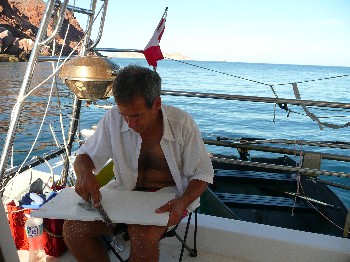
Garett fashioning the cover for the plethora of electrical
wires bunched in one place under our hard top.
Thanks to his ingenuity, it looks much better now
and the wires, which are well sealed, are even a little
more protected from the elements.
Carllie wanted to go on a snorkel on her own so I experimented by rigging up Carllie with one more two-pound weight as we had noticed that she is still quite buoyant with her new wetsuit on. With the extra weight it gave her now a total of six weights for a total of 12 pounds (equivalent to a small anchor) and she snorkeled on her own to the nearby rocks. She found that the extra 2 pounds really made a difference and allowed her to get to the bottom and stay there better. She reported that there were a lot of fish so though it was almost 5 p.m. she encouraged me to see if I could get another fish for dinner.
I quickly got suited up and was off over to the rocks that were more like bolders and sure enough saw a lot of fish. The Leopard Groupers which were so blase in Este Ton two weeks ago remained extra wary here. Any slight movement and they take off. It is very difficult to get close enough to get a good shot.
It was getting late so we decided to head back to our overnight spot behind Mejia Island. On the way there we talked things over and decided to stay another two days up here in Puerto Refugio as we still had enough food and water so Carllie could finish up her article.
As we came around the corner into the pass, lo and behold, we see another sailboat! We had been here five days and had not seen anyone else except a few Mexican fishermen camping off and on on shore, so we were quite surprised. There is actually someone else on the planet! We will have to go over and say hello tomorrrow.We still managed to anchor in the same cove but further in where it is a bit more shallow.
Sunday November 4, 2007
Carllie: This morning we dinghied over to Isla Granito, just over two miles from our snug anchorage in Puerto Refugio in the protected area between Isla Mejia and the big Isla Angela de la Guarda, so I could swim with the sea lion pups! I had prepared myself yesterday when we were anchored in our lovely little day anchorage on the open, north side of the big island where there are fewer bugs and better snorkeling. The trick with swimming with the pups was going to be getting back into the dinghy in full snorkeling gear. Ours is not an inflatable, but a PortaBote, with flexible hard rubber sides that angle out like a regular row boat. So I practised yesterday. It took several tries and a lot of hysterical giggling, but I as finally able to do it when Garett said, “Imagine you are a killer whale and you are throwing yourself up on land to grab the seals!” The whale bit wasn’t hard, but grabbing cute little seals went against the grain. However, I got the picture and used my flippers to create some momentum as I flung myself up and partially over the side of the boat, then fell the rest of the way in. Now I had confidence that I could get back into the dinghy from a position anchored about 20 feet from the islet without having to take it ashore and disturb the sea lion colony.
My previous attempts to swim with sea-going mammals like dolphins back at Bahia Tenacatita in February had been a dismal failure. Even though at the moment Garett and I both had a lot of laughs over it, I panicked as soon as I was in the water with these big, mercurially fast creatures. Would I also panic when I was in the water surrounded by sea lion pups? I did not think so, as I had gotten to know these endearing creatures on our two earlier trips to the islet and felt peaceful and at ease with them and the colony. On our first day at Refugio we were more or less reconnoitering the colony, but for about 30 minutes we just sat in the dinghy letting the curious babies swim up to us, bobbing their heads out of the water and getting closer and closer. Then two days ago, Garett swam with them off the dinghy while I watched and took pictures. By now, I was very fond of these little ones who are so adorable to watch on shore as they hop around on their two front flippers and wiggle their little bodies along behind, looking for an available teat to suckle, and in the water as they cautiously kept a little distance from Garett yet popped up closer and closer. I resolved not to let fear register or concern about getting back into the dinghy, to just go for it and enjoy it.
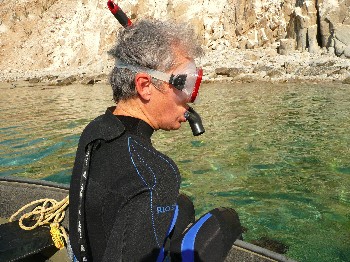
Ready to jump into the water with the sea lion pups…
So as soon as we were anchored and I was pretty sure a big bull sea lion was not going to head my way, I slid over the side of the dinghy into the water, much faster than Garett had expected I think. In the twinkling of an eye, I was surrounded with little bodies twisting and turning under the water, around and under me, heads popping out of the water to check out Garett in the dinghy behind me.
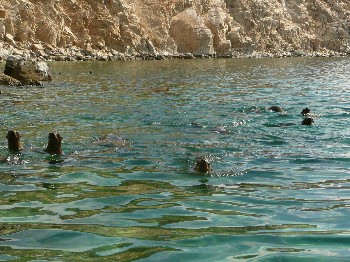
Now I am in the water and they are swimming
over to check me out…
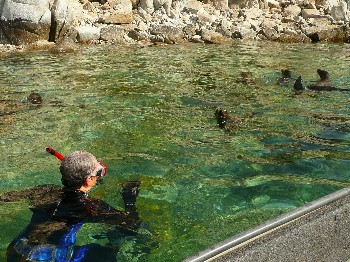
They swam all around and
under me the whole time
I was in the water.
Eventually a few young adults also
swam by me, though
they were not really interested in me.
They were just like little children crowding together to watch a puppet show at a fair. Keeping my face in the water I swam backwards so I could watch them both under and above the water, then turned over to the regular face-down position so I could more clearly see what was going on under the water.
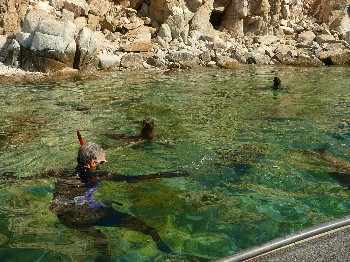
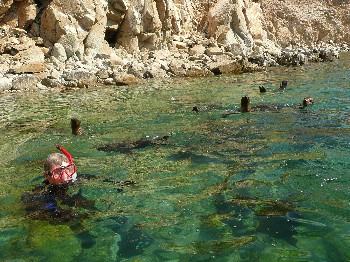
It was such a peaceful and
enjoyable experience swimming
with the sea lion ups
that I did not want to leave…
Under the water they are so graceful, lithe and fast. As they grew more relaxed and confident with me, more pups ventured close although some were a little more like teenagers and there were a few young adults, not huge, possibly females. Some floated vertically upside down, while others turned slowly or propelled itself smoothly through the water, looking altogether like an undulating mass of sea weeds, a ballet of junior ballerinas.
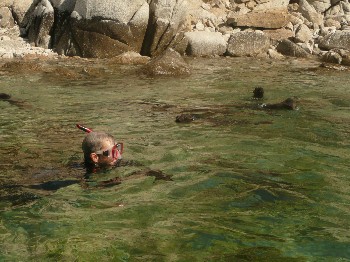
I would recommend this experience to anyone…
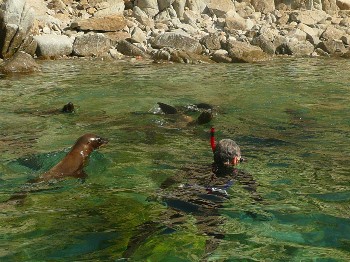
The pups even though young
are so fast and graceful
in the water…
One pup in particular, who had been tagged with red tags, stuck close and I could always find him in the foray. I crooned to the sea lions, pups and young adults, the whole time, and each time I considered concluding our playtime, I looked for my little friend for one last visit. This little creature swam very close under and around me, and often held my gaze as he glided past. If there is such a thing as telepathy between humans and animals, I believe I experienced it today. This has to be one of the highlights of my finite experiences in life.
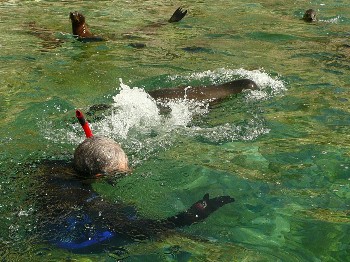
One pup in particular became
my special buddy and stuck close by
most of the time I was
in the water. I kept
my head submerged so I could
see both on top and under the
water, and as he swam
closely by under the water,
we held each other’s gaze.
I crooned to the babies the
whole time I was in the water,
but I believe I developed a little
bond with this special creature.
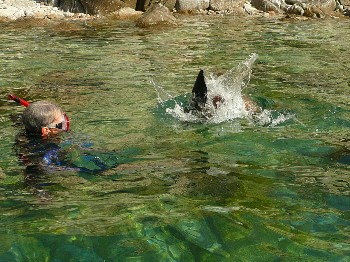
The pups were so fast.
We soon realized that
if I dove, they immediately
scattered–in the
blink of an eye.
I was glad to see
this as sea lions
are predated by sharks,
and their speed saves them.
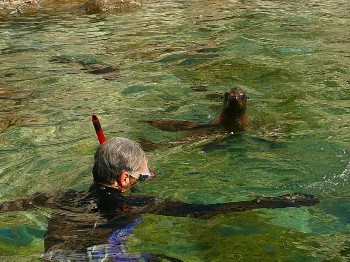
This is good photo of my special friend…
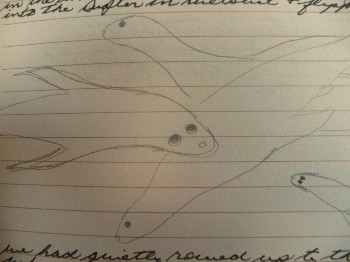
My attempt to depict the beauty
of the underwater
ballet of sea lion pups
and young adults. It is so
graceful and colorful,
difficult to convey without
an underwater video camera.
Finally and reluctantly I threw myself back into the dinghy and said goodbye to our little friends. We do not know when we will pass by this way again, perhaps in nine years, perhaps never. So I will tuck this memory safely away in the special compartments of my mind, to take out and view like a precious jewel every once in awhile when I a.m. back home living the city life.
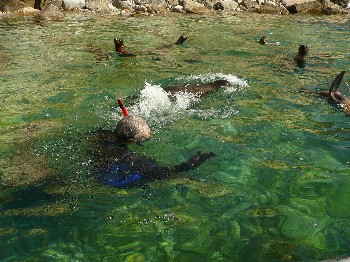
The pups gather for a better look at me and
at Garett in the dinghy, swimming
mercurially fast under the water, twisting
and turning.
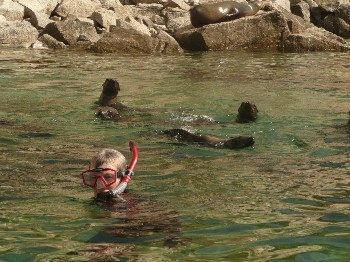
The experience was such an inspiration, my spirits were buoyed up all day. We enjoyed another idyllic afternoon in our day anchorage, having lunch, writing, snorkeling and spearfishing, and I concluded my a day of writing inside the cuddy cabin with a refreshing swim au natural around the boat followed by a fresh-water shower. What a great way to end a day’s work! There is something about swimming in salt water that invigorates and stimulates a little more than fresh water, and my vigorous crawl around the boat gets my heart rate up.
After my swim with the sea lions, after we had finished our morning routine and Garett had introduced himself to Dave on the monohull that came in last night, we again toodled over to our day anchorage. Dave has been down here four years now and spends much of his time doing computer programming shut up in his boat. Hopefully, this was not the case in the mid-summer heat up here!
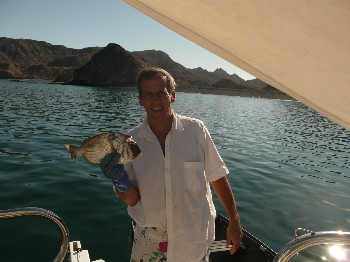
Garett caught a sizeable fish today.
These fish make our dinners varied,
delicious, and more nutritious.
Over in West Bight Garett speared two fish, though not the big grouper he lusts for. We cooked it in tinfoil over the barbecue and ate it with a vegetable pasta dish while we watched Lord of the Rings: Return of the King. Followed by Roisbos tea and a piece of yummy low-fat banana loaf that I have recently invented per force due to running out of cooking oil, we had a feast for kings!
Monday November 5, 2007
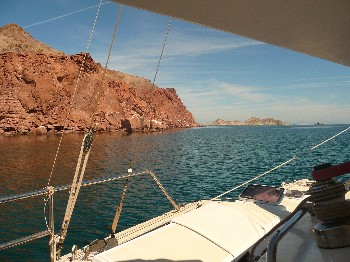
Enjoying our last afternoon at our day
anchorage at the West Bight.
Today, anchored for the last time in our day anchorage tucked in under the cliff where the water is warmer and the fish more plentiful, I tried my hand at spearfishing. I had to use Garett’s Hawaiian sling as it is too hard for me to arm his JBL38 Special speargun.Wow! Spearfishing is not easy. It takes a lot of coordination. I found that simply swimming and diving with the sling was difficult as it threw my balance off. Also, sometimes I forgot to do certain essential things like pressurize my mask when diving. It takes a lot of patience and many dives to line up those fish exactly right. There may be a lot of fish around, but often they are swimming so that their backs, not their tummies, are exposed and that would be an unsuccessful shot. I tried several times and even hit two fish, but they wiggled away. I now have even greater appreciation for Garett’s skills and the fish he brings home after his forays…
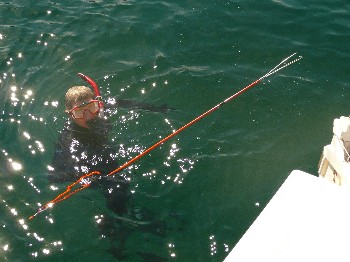
Carllie attempting spearfishing with
the Hawaiian sling. It is much harder
than it appeared.
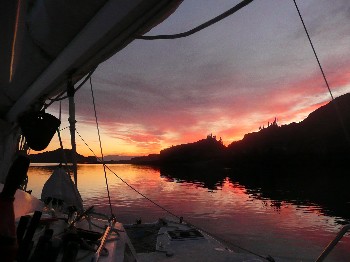
A perfectly beautiful sunset on our last day
at Puerto Refugio.
Tuesday November 6, 2007
We are now down to our last 5 gallons of water and so we are back off to B.L.A. but before we left I went for one last spearfishing outing at the pass in search of the elusive yellow grouper.
I did not see my nemesis but did come across some other fish one of which I had never seen before. It had a narrow tail that was very red and it was also red under the mouth. He looked pretty big as everything does under the water and he was swimming with a whole bunch of the common black fish of the reef. He did not seem to see me and I fired and I got him. I then went into phase two of the operation which is to now swim to the fish and grab him and hug him to subdue him so that he does not thrash off the spear. I managed to swim back to the boat which sure seemed a long way and was exhausted. He came in at all of 2 pounds which I know does not seem like much, but it was still a struggle and when I filleted it, there was lots of fish for our evening meal. I have no idea what I will do when I get a 5 or 10 pound grouper!
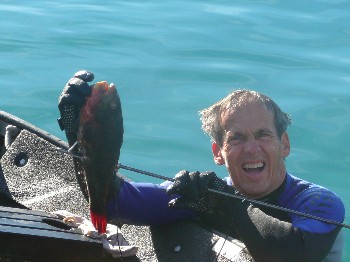
Garett’s last mysterious fish speared at
Puerto Refugio.
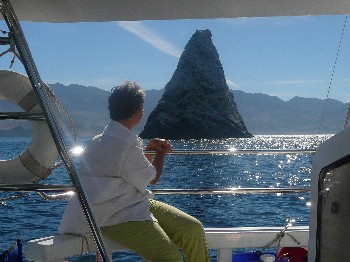
Our last sight of Sail Rock, leaving Puerto Refugio.
Carllie put our fishing line out of habit as we left Puerto Refugio more out of habit than anything else since it has been about 8 months since we caught anything on the hand line. Sure enough just a few minutes later Carllie spotted a fish on the line and we pulled it in. At first we though it might be a mackerel but it turned out to be a Bonita tuna which when barbequed that night which was the best fish we had every tasted.
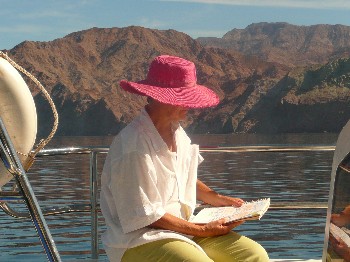
Relaxing in the warm sun en route to B.L.A.
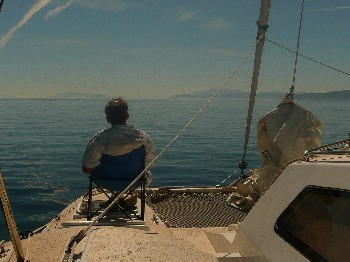
Garett finds an intriguing position for our
new small collapsible canvas chairs. Okay
in settled weather…
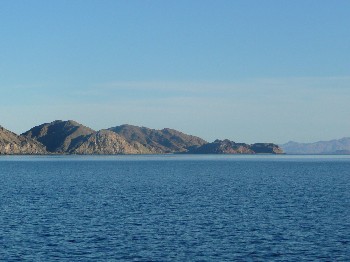
Approaching Bahia de Los Angeles.
Wednesday November 7 to Saturday November 10, 2007
As were down to 1 gallon of water, 2 gallons of gas, 1 lime and 1 can of salsa sauce (not counting our containers of dried legumes, rice, barley and sprouting seeds as well as a few cans of pasta sauce and Carllie’s baking supplies) we had to do a lot of stocking up over the next three days. We seemed to do endless trips to the various tiendas where we found the items we needed. They are all like corner grocery stores. I would say halfway between a 7-11 and a Sunshine Market (the famous corner store near where we live in Vancouver).
In between shopping Carllie worked on finishing up her next instalment for Multihulls Magazine, and we jointly did the web update. There are now only two cruising boats up here now, us and Steve and Carolyn on Lightheart.
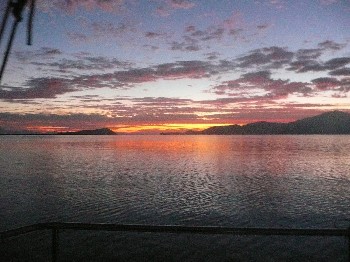
Beautiful sunrise in B.L.A.
Late on saturday November 10 we finally pulled away from B.L.A and headed over to La Mona about 6 miles south where Carllie had dove to collect some very delicious clams three weeks previously. This time, we planned a foray to a lagoon on shore where we hoped to get a bunch of clams much more easily. We got there just at dark but there was a real swell rolling in wrapping around the point, though there was no wind, which made for a very rolly diner and uncomfortable sleep.
Sunday November 11, 2007
Carllie: We had to motor quite a distance in our wee dinghy (with only a 2 stroke 3.3 hp engine) to find the lagoon that our shore-based friends had told us about when we last visited La Mona. We checked out every little plausible spot on the beach, but could find nothing. Garett was ready to give up, but I have this compulsion to collect clams, so I said, "Let’s just go a little further." Finally, we saw some signs on shore that indicated it could be the dried lagoon, as it was now low tide. Sure enough, when we reached it we found long stretches of sand between dried waterways, and many empty clam shells littering the sand. At first we looked for clams that we could just pick up, but this was really not the method I expected to use as I have always had to dig for clams except the time I dove for them the last time we were at La Mona. When the tide goes out and leaves them high and dry, clams do not sit on the top of the sand waiting to be grabbed by hungry seagulls. They suck themselves down into the sand. So we started exploring with the garden trowel I had brought along, and sure enough we found beds and beds of them that just continued non-stop. These guys were the nice little clams much like the Japanese Littleneck Clams we gather at home at Jedediah Island, with the conveniently sized "baby clams", so perfect for clam chowder and creamy clam pasta. I insisted on filling our big pail, knowing that although a pile of clams always seems like a lot, when you steam them open you are lucky to get a small soupbowl full.
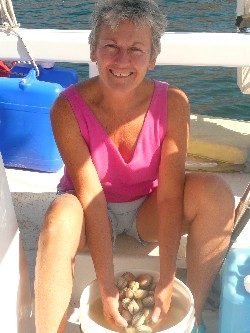
Carllie, delighted with our digging
catch of clams at the lagoon at
La Mona.
Garett: After collecting clams we headed back to B.L.A. so I could send off an email with a fix for a programming problem back in Vancouver. By 4 p.m. we were finally away again, even if it was just a six-mile distance, and made our way to Puerto Don Juan where we joined our friends Steve and Carolyn on Lightheart. We were only two boats in this beautiful bay which is a far cry from the 20 to 40 different boats that are always here during hurricane season.
Monday November 12, 2007
Steve came over early and helped me put a new steel leader on our great new fishing lure that we bought (Carllie picked it out, and it works a treat). It is a Rapala lure which we had heard is the best lure to use up here other than live bait.
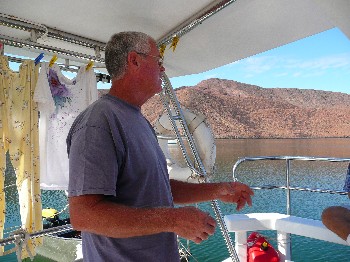
Steve from Light Heart visits to attach a steel
lead line to our skookum new lure.
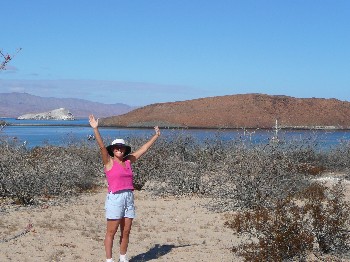
Since we had been boat bound for several days we went
for a little hike in the surrounding hills before making
our 35 mile crossing over to Isla Istanque.
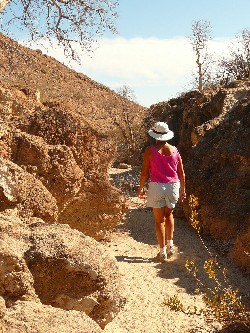
Walking through a "mini canyon"
on our long hike at Puerto Don Juan.
After long walk on shore we motored to Isla Estanque, 35 miles away, as our friends Michelle and Bernie on Momo had stayed there a week in October and told us it was full of fish to spear and had very clear water.
There was no wind to speak of but we did see about 20 fin whales sunning themselves and frolicking in the calm waters. These whales are not as boisterous as grey whales and humpback whales that quite often seen breeching almost totally out of the water. The fin whales just barely clear the surface with their small dorsal fin and sometimes just stick their eyes out to get a view of you. They look like very big torpedoes.
We managed to make it to Estanque just in time before dark settled. It is a very tricky anchorage to enter, as you have to avoid a long reef by going around the island, and there is not much water at entrance.
I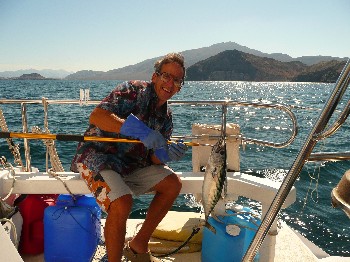
Carllie’s first catch, though Garett gaffed it.
It was a delicious Bonito Tuna. Best we
have ever eaten.
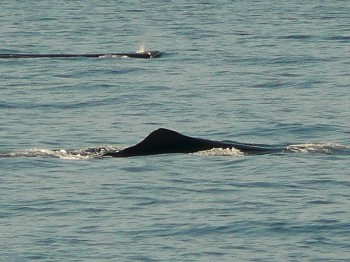
Fin Whales en route to Isla Estanque.
Sure enough we were cutting close on our arrival at Estanque. It seemed very remote.
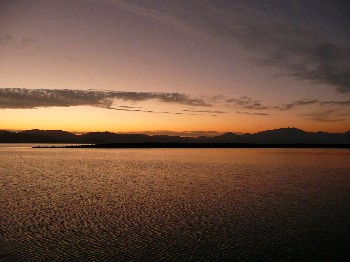
Our first site of Isla Estanque, which we had to motor
around to the right to avoid the long reef extending
out from the visible reef on the left.
Tuesday November 13, 2007
Garett: Our friends Michelle and Bernie on Momo had spent a week at Estanque in the summer and really liked it but when we woke up in the morning it didn’t look very inviting. Much to our disappointment, we found it to be a dark and gloomy place even in daylight the next morning, and still had lots of bugs. The shore is rocky with no inviting sand, and the island itself simply black rock, quite steep with no apparent hiking trails. At the time we visited the water was not clear and the water was a very cold 66 F, so snorkeling was out of the question, and we had had enough of bugs, so almost as soon as we got up we decided to call it quits and head for a more hospitable location. It is amazing how anchorages can appear to different people or to yourself on another trip in better weather.
We had a quick conference in the cockpit and decided to move 40 miles to the south to San Francisquito, giving us just barely enough time to get there in the remaining daylight.
I tried to raise the main sail and managed to get the halyard jammed again between the pulley and the top of the mast. This meant that the mainsail was jammed about 2/3 of the way up and could not be taken down without me going up the mast. This was the same problem we had at Point Conception on the Southern California coast last year. We are going to have to do some thing as a permanent fix such as gluing some type of guide at the top of the mast to prevent this jamming, as it could be serious problem if we cannot get the sail down in a storm or in tight quarters while doing the big crossing to Hawaii.
We were still able to sail with just screecher and jib for about five of the eight hours so it was still an enjoyable day.
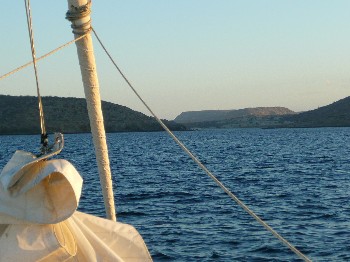
Heading for Bahia San Francisquito.
We arrived just before sunset and I climbed the mast to unjam the halyard, so we were able to finally lower the sail. When we get to some really calm waters I will have to go right to the tippy top of the mast to permanently fix things.
Wednesday November 14, 2007
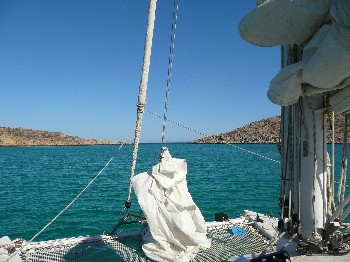
Looking north through the narrow
protected entrance to Bahia
San Francisquito
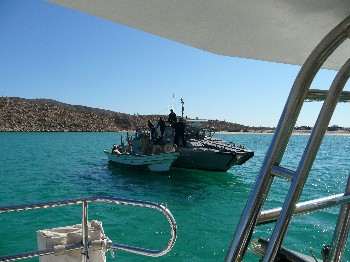
We thought we might be boarded by this navy boat
but they just stopped to say hello to
the army guys in the panga
who have a small outpost here
to make sure the airstrip on
shore is not used by drug runners.
After two full days of travelling we took it easy today and then at about 3 pm went for a long walk across the peninsula over to where there was an air strip and a small beach resort.
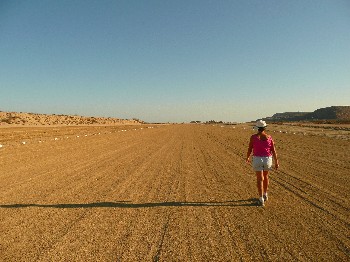
Walking along the long airstrip at Bahia San Francisquito.
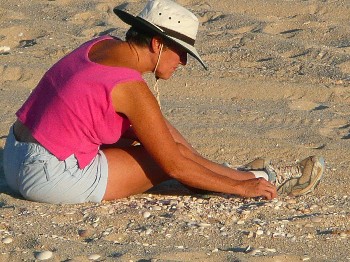
Sifting shells at the beach we had hiked
to
from Bahia San Francisquito.
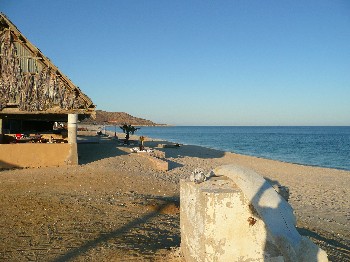
There was small resort on the beach but it
was very beat up and had seen better days –
about 20 years ago. Beautiful spot though.
Thursday November 15, 2007 – The Lightening Storm at night
The dilemma we now faced was to how to do the next 80-mile leg to Santa Rosalia. It is obviously too far to do in one daylight sail and there are no really good protected overnight anchorages along the way for shelter. We decided we would stay near San Francisquito snorkeling and exploring a small bay about 3 miles to the north during the day and then we would leave at 4 p.m. and travel through the night and arrive at 8 a.m. the next day in Santa Rosalia. The plan sounded good as the forecast on the morning net said "light winds today – nothing happening in the Sea of Cortez for the next 48 hours".. Little did we know what was in store for us.
We had a spectacular sunrise this morning. Note the cloud pattern. I found out later in a books that this is called the "Seeds of Rain" cloud formation.
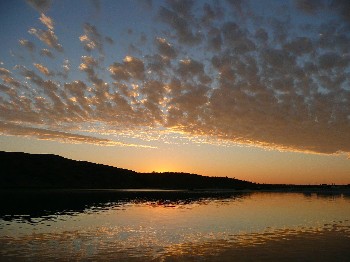
Cloud pattern foretelling rain, at
Bahia San Francisquito.
After we motored out of San Francisquito and back around the corner to one of the two small Caletas Mujeres that are both open to the north and east so not feasible at this time of the year for overnight anchoring but ok for a temporary day anchorage, we quickly dinghied to shore to walk the beautiful sandy beach.
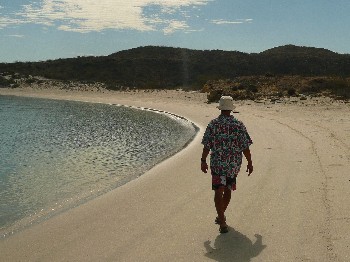
Walking the beach at Caletas Mujeres, near San Francisquito.
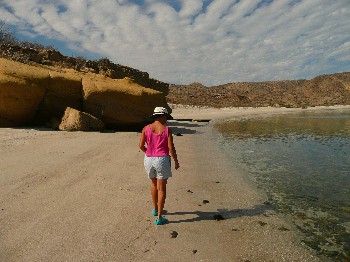
Again note the formation of the clouds.
We returned to Light Wave and dinghied to shore to snorkel and spearfish over the rocks. The water was quite clear but when you dove down past about 10 feet it got really cold. We caught a couple of fish but again there were some big ones that got away!
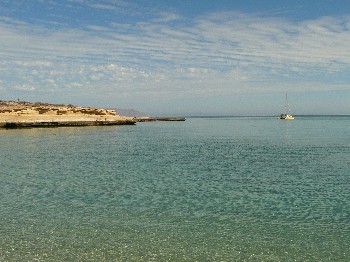
Beautiful Caletas Mujeres.
After our snorkel we napped for a couple of hours so we would be ready for to leave at 4 o’clock for our the overnight passage. Should be a walk in the park!
The Fun Begins…..
At 4:30 p.m. as we motored out in the calm conditions we noticed big dark clouds far to the west over the mountains and the interior of the Baja Peninsula. I commented to Carllie, "We might even some lightning over the mountains tonight…" which is a common occurrence in summertime when the land is heated up by the sun.
By 6 o’clock it was very dark and we saw some flashes of lightning far to the west. We were enjoying the light show while we were going south with no problems. Then we listened to the weather on the evening South-bound Net on 6122 khz where there was now suddenly talk of "low pressure over the Baja and a cold front, with gusty southwest winds, crossing into the sea tonight." What had happened to the "light winds today – nothing happening in the Sea of Cortez for the next 48 hours" of the morning forecast?? The weather can be very unpredictable at times as there are very few reporting stations. Don Anderson on Summer Passage who gives his fantastic twice-daily forecast from his home in Oxnard California often says it is impossible to accurately predict weather and sea conditions when you are "on the beach" in the Sea of Cortez.
Unfortunately, it was too late to turn back as it would be very difficult to negotiate the entrance back into San Francisquito in the dark, so we continued on. By 7 p.m. it looked like the lightning would stay over the land west of us. Then the winds came up from the southwest and we were able to start sailing, which was good. The bad part was that was one of the first signs of the cold front.
There was no moon and with the cloud cover it was kind of hard to see how the cumulonimbus clouds might be building up ahead of us. I decided to turn on the radar to confirm our distance from shore and I was shocked to see not just the outline of the shore on the radar screen but the intense rain from a half-dozen two-mile wide storm cells about 10 miles directly in front of us to the south. Not good. Where there is intense rain in a storm cell there is usually lightning. They weren’t moving straight towards us but at a bit of an angle. So I changed our course so we could hopefully slip between them. So from 8 p.m. to 1 a.m. we dodged endless bunches of these small storm cells with lightning, rain and thunder. It was like a different world. We had not had rain in Mexico for our last six months of sailing, so it was quite shocking to be in it. We had to dig out our storm suits and boots. I stayed up all night dodging the flashes in the choppy waves, even though Carllie was willing to take a watch.
By about 2 a.m. the worst was over but now there were the steep seas from the eight-mile fetch from the shore. At 4 a.m. Carllie came on watch as we continued to make our way to the lights of Santa Rosalia that we could not see in the distance.
Carllie: Since this experience, we have both read Godforesaken Sea by Derek Lundy about the 1996-97 Vendee Globe solo race around the world by way of the Southern Ocean and Cape Horn, and revised our perspective on what scary seas really are. Our friend Garett Haynes, who has since passed away, gave us that book, and we sure enjoyed it. It is amazing what these highly qualified men and women have to cope with to complete that race: seas 60 to 70 feet high and winds sometimes 60 to 90 knots, several knockdowns, and sometimes pitchpoles. And that was in the antipodes "summer!" The Southern Ocean is not my idea of a nice offshore cruising area. It puts our forthcoming crossings of the Pacific Ocean to Hawaii and then home to Vancouver, planned for months well clear of hurricane seasons, in perspective, and we are now almost looking forward to that new adventure!
Friday November 16, 2007
Garett: With Carllie on watch I woke up at 8a.m. to beautiful clear blue skies with not a cloud in sight. It was like the night had never happened. Was it a dream? Carllie was there; she was my witness!
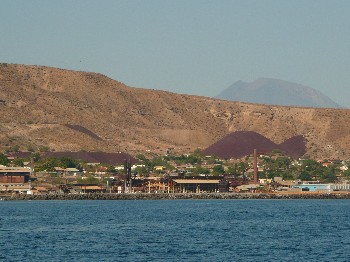
Anchored at Santa Rosalia. You can still see the purple
pile of tailings from the copper mine in the right foreground
Entering the centuries-old breakwalled harbor at Santa Rosalia, we motored past the expensive Singlar marina as far in as we could go and anchored off the old Santa Rosalia Marina which is very very basic with slips for only six boats. They have a little clubhouse in a beat-up falling down warehouse which a couple of volunteers run, offering showers and a book exchange, and charge a very nominal fee for nightly anchoring in the harbor on behalf of the Port Captain. Everything is on the honor system.
We were both exhausted after last night’s ordeal so we slept for a bit. I went ashore on my own and arranged for a propane tank to be filled, some gas, and water to be delivered to the dock, then scouted out what was in town while Carllie continued to rest.
The town had been built around a thriving copper mining industry since the 1850’s, but the smelter closed down in the 1960’s, and so the economy has converted to tourism. It is quite a cute place and very clean with the usual friendly Mexican people.
Saturday November 17, 2007
Carllie: As the mining company was owned by the French, they provided their own executives who built French-style homes, very unlike the Mexican casas we have seen thus far. These houses are like those you would see in New Orleans–wooden with big surrounding verandahs and covered upper verandahs with wrought iron fences. We visited the Santa Rosalia Museum and saw a lot of old equipment used in the mining business and photographs of workers hauling coal by hand, using donkeys and mules, working down the shafts. We can only hope the local Mexicans were not exploited, but we have our doubts as this is the usual way when people from wealthier and more jaded countries set up business in a third world country. It still happens today. Look at Nike, to name only one.
We enjoyed a walk around town and found a great place to have breakfast. The town is built on the sides of the hills and mountains, so walking around involves a lot of climbing up and walking down stairs in the sidewalks. The views were great.
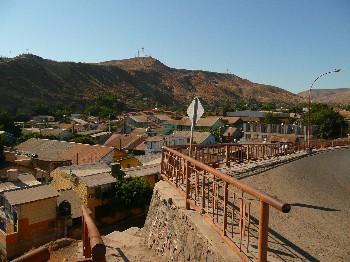
The old mining town of Santa Rosalia is built on
hills, and a good walk gives you great views.
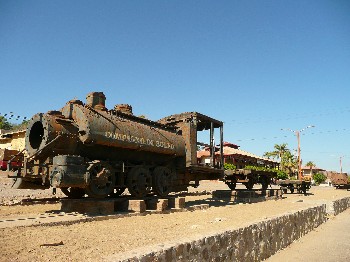
One of the old mining trains.
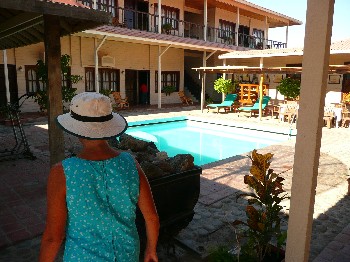
The famous Francesca Hotel which has been rebuilt.
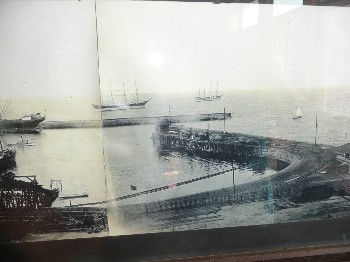
Photograph of old tall ships in and outside the Santa
Rosalia harbor, inside which we are now anchored,
on display at the town’s museum.
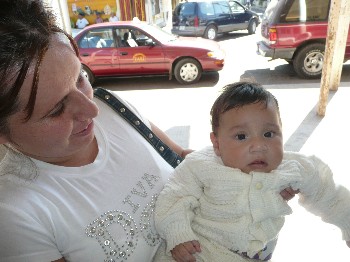
Alejandro, three months old, visits a tienda
while we were doing our shopping.
Again, we stocked up with a bit of fresh produce, and returned to Light Wave, who has now recovered from her trip dodging lightning cells and waited for us secure in the Santa Rosalia harbor.
Sunday November 18, 2007
Garett: It was time to move on after two nights in this breakwater surrounded commercial harbor. Our objective was to sail the 18 miles to the south side of Isla San Marcos. When we had checked out emails the day before, Michelle on Momo had emailed Carllie that the south end of the island was very nice and there was great snorkeling and spearfishing at Roca Lobos, a one-mile dinghy ride from the anchorage. They reported that it had the most fish they had ever seen.
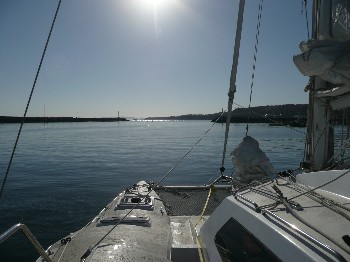
Leaving the harbor at Santa Rosalia.
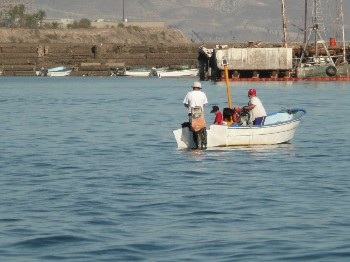
Fisherman with his sons having fun on
a Sunday.
In just three hours we made the quick hop to San Marcos, enjoying a really fun fast sail most of the way. The island is a one big gypsum open pit mine, with a small dusty town of about 300 people for the workers. We anchored off the spectacular white cliffs but stayed on the boat during the afternoon as it was too windy for the dinghy trip to Roca Lobos (meaning sea lion rock, though there are no sea lions there now) for snorkeling.
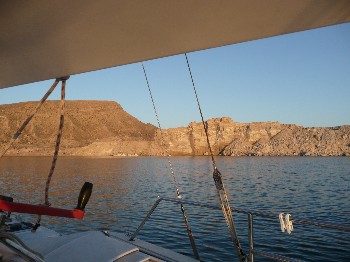
Nearing our anchorage at Isla San Marcos.
Monday November 19, 2007
We were up early and excited about our trip to Roca Lobos. We did not take our camera as we did not know whether we would find a beach to could take the dinghy ashore. I would have to dive from the dinghy if we didn’t and did not want to take the chance of getting the camera wet.
After the 15 minute ride over we found this tiny little pocket beach about 10 feet wide where dragged the dinghy out of the water. Although we already had our wetsuits on, beaching the dinghy made it much easier to get into the rest of our gear and flippers. Even as we approached we could see how clear the water was.
When we got into the water we realized just how incredible a place this was–even better than Puerto Refugio where we had spent a week earlier in the month. We were amazed by the many different types of fish, some of which being pretty reef fish that we had never seen before, as well as the sheer quantity of them.
We stayed in the water for over an hour even though it was only 70 degrees F, and I speared four fish for dinner so it was a great day.
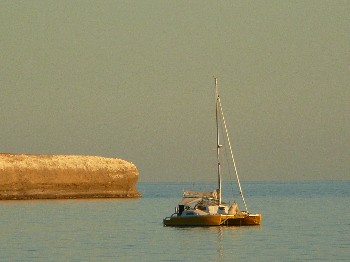
Light Wave anchored off the gypsum rocks at
Isla San Marcos.
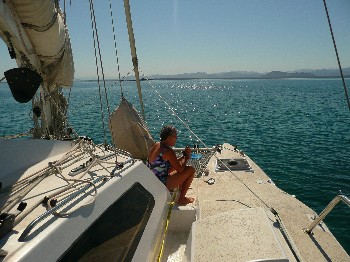
Granola for breakfast after our morning snorkel.
Returning to Light Wave, after our now traditional afternoon siesta, we jumped into the dinghy for our exploration of the shore and walk to the village. The island is just a big open pit quarry.
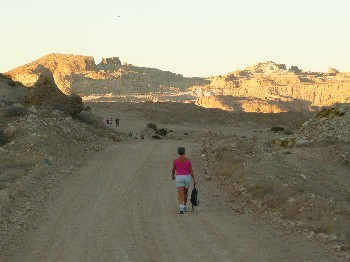
Hiking down the mile-long road through the
gypsum quarry to the town at Isla San Marcos.
The store was closed but we did find a little tienda with ice cream stand that even had waffle cones!
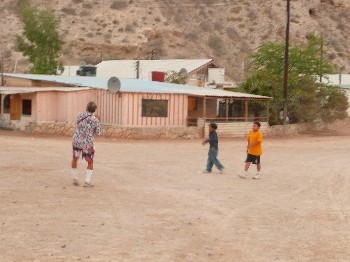
Garett playing football with some of the local boys.
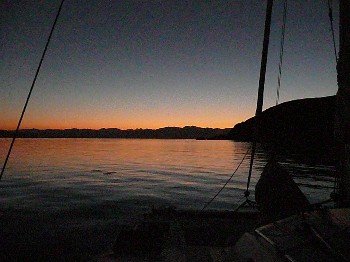
Sunset at the conclusion of another
great day in the Sea of Cortez.
Tuesday November 20, 2007
We were up early and right before any breakfast we headed off to Roca Lobos. Since we knew we had a beach to put the dinghy we took the camera along with us this time.
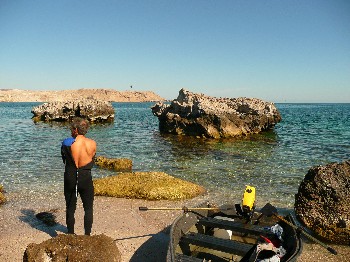
Getting wetsuits on for the tepid
waters at Roca Lobos.
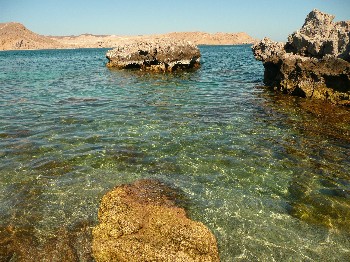
Crystal clear aquarium at Roca Lobos.
Spearing the Really Big Fish!
Last night we had run out of DVDs to watch (as we only own about four) so we went back to reruns and watched "Finding Nemo" for about the 20th time. Before coming to Mexico and starting to snorkel and discover the underwater world, this movie was our sole source of knowledge of the marine world. What can I say…? One of the scenes in the movie shows some fish disturbing a sole that was hidden in the sand with only his two eyes showing. As you probably know sole and halibut are types of bottom fish which lie on flat on the bottom and both eyes are on the side facing up (evidently they are born with one eye on each side of the head, but as they grow up one eye "migrates" to join the other). Well anyways back to the spearfishing… We had just started snorkeling and I go over this patch of sand in about six feet of water and see the eyes in the sand just like in "Finding Nemo." I say to myself, "That’s a sole!" and I could see from its outline that it was big, the biggest fish I had ever seen under water. Carllie was right next to me watching. I should digress to what my friend Bill on Moon Hunter who is my spear fishing mentor told me three weeks ago: "Garett, when you spear a big fish you don’t just leave it on the end of the spear and swim with it as it will thrash around and throw the spear off. You have to swim to it immediately and grab it and hug it to your chest so it can’t move."
I said, "Whoa! Hold on minute. No one had ever mentioned this ‘hugging’ thing before. I thought the spear ‘gun’ is supposed to subdue the fish!"
"No you can’t rely on the spear gun with bigger fish, you have to get a hold of it with your hands and stop it from thrashing around."
I told Bill skeptically, "I am not sure about this. I don’t know if I can do it."
Well back to that sole that I am eyeing as it lies on the bottom–if there was ever a fish that was in the "huggable" category this was it. I took a breath and dove down so I was just a foot away from it and pulled the trigger. Yikes! Nothing happened! In my excitement I had forgotten to take off the safety. I bobbed back to the surface, quickly unclicked the safety and dove down again and almost closed my eyes as I clicked the trigger as I knew this was going to be "hug time."
Sure enough, my full vision from within my goggles was filled with this thrashing sole and so I swam towards it and kind of hugged it and pulled the spear and the fish to my chest as I struggled with it as I started to swim back to the beach which was fortunately not too far away. Luckily, as soon as I hugged it, just as Bill had predicted, it stopped thrashing.
I finally got onto the sand above the water and was able to finally subdue it. Wow what an event!
That night we feasted on what we later discovered was barbequed "Cortez Halibut." (Carllie had insisted that it was too big to be a sole and wondered if it might be a skate, but Bill Brooks my spearfishing guru confirmed it was a Cortez Halibut). It has to be the best tasting fish we have ever eaten. There was so much of it that I had two huge portions to Carllie’s one, and we had a whole long fillet left that Carllie used to make a delicious seafood chowder the next day.
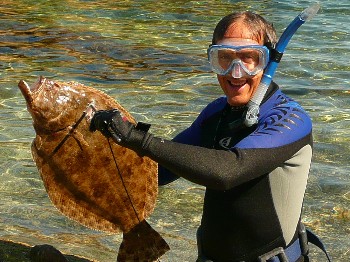
Garett’s biggest spearfished fish yet!
A huge "Cortez Halibut" he speared at Roca Lobos off
Isla San Marcos.
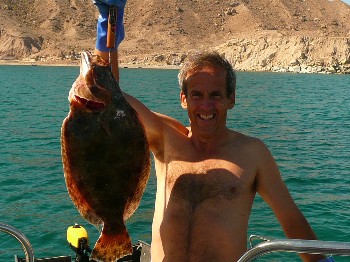
Weighs in at 8 pounds!
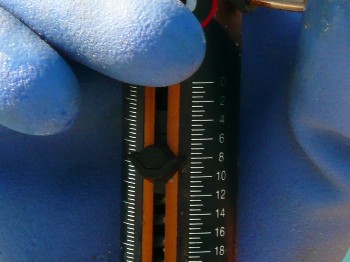
A solid 8 pounds!
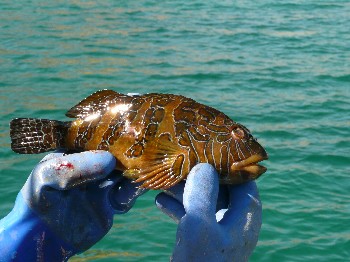
A small Hawkfish rounded out the catch of the day.
This little guy was very well camoflaged lying still
on top of the rocks where Garett was hunting.
Though it seems small, it made good eating!
Wednesday November 21, 2007
We spent one more special day at Puerto de Viejo as the south bay of San Marcos is called. We snorkeled again at Lobo Rocas but didn’t fish (still lots of halibut left…)
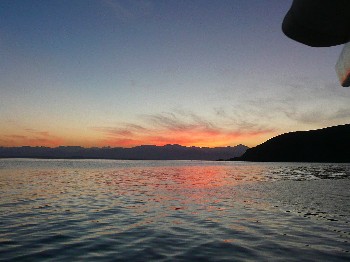
Another great day anchored at Puerto de Viejo,
Isla San Marcos.
Thursday November 22, 2007
We were finally off to Punta Chivato which is supposed to have a very good shelling beach.
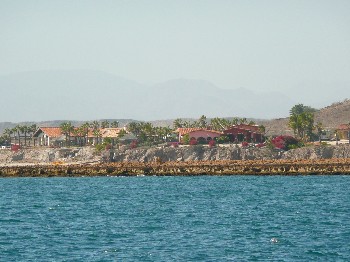
Slowly making our way back to civilization we come
by some luxury homes on the beach at
Punta Chivato.
Carllie: Although the beach was literally covered in huge shells, they had been well picked over and few were really collectable. Just huge.
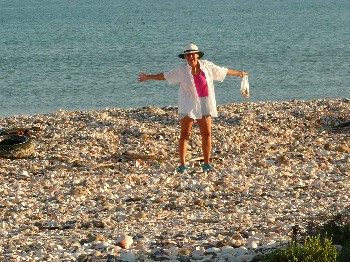
Bonanza of huge shells at Punto Chivato, though
few were collectible on this part of the beach.
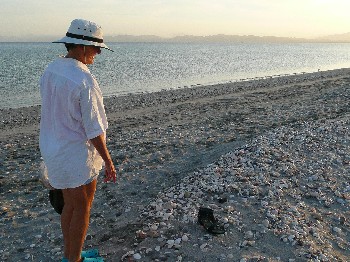
The shells go one for 2 miles.
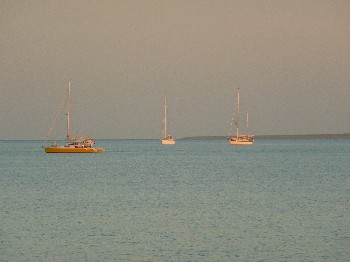
We now had to start sharing anchorages with other boats.
First time in a month
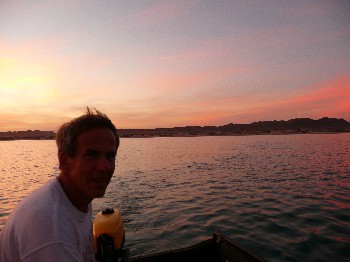
Motoring back to Light Wave from our
first foray on the beach at Punta Chivato.
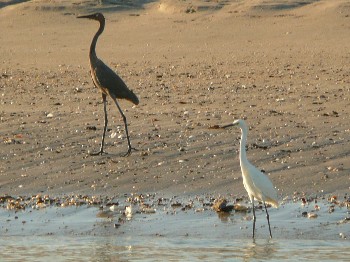
White Heron and another darker heron on beach at
Punta Chivato.
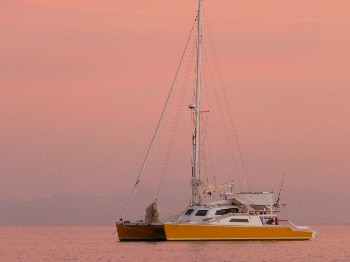
Many times at sunset the sky to the east goes this
beautiful pink color which makes
for good pictures.
Friday November 23, 2007
Carllie: Today we dinghied to shore again to walk to the very fancy hotel on the point. On the way, we had to walk the whole length of the air strip, as Garett wanted to take a close look at three very beautiful Cessna 182s and a Shrike Aero Commander, thanks to his history of getting his flying license when he was 16 and spending several grueling years working as an aircraft broker.
We visited the beautiful hotel on the point, and have to say that this is the most beautiful hotel we have seen anywhere. Of course, we are not world travelers, but this place is truly outstanding. We hope we may return for a week of luxury at some future point when we are land bound. A "junior suite" has its own patio close to the sea, and you can walk right down to the beach from your suite. The price of necessity includes food, so all you have to do is relax, enjoy the beautiful scenery, snorkel and kayak (all equipment provided by the hotel), swim in the ocean or the hotel’s pool, and enjoy your luxurious air-conditioned suite.
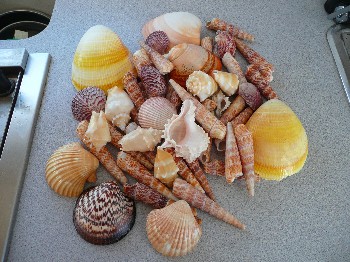
The seashell catch at Punta Chivato.
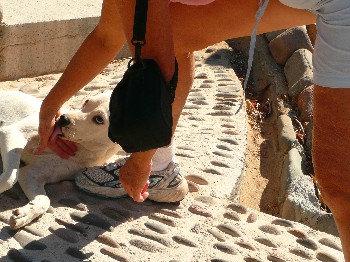
This very love-starved female dog lapped
up Carllie’s attention as we walked to the hotel.
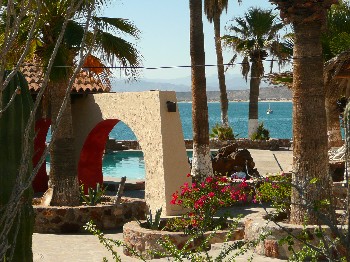
The beautiful hotel grounds at Punta Chivato.
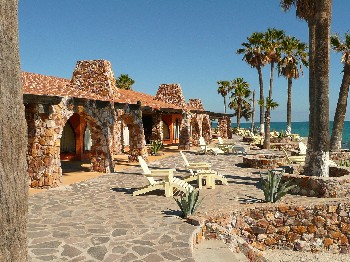
Suites with their own verandahs look out on this
fabulous view.
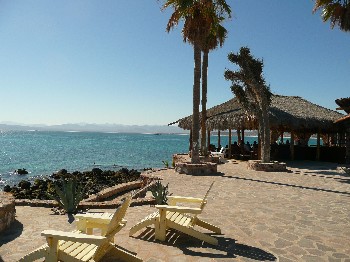
We hope to go back some day when we are land-bound.
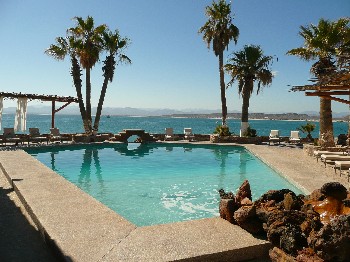
Beautiful pool looking out on the water and surf at
Punta Chivato.
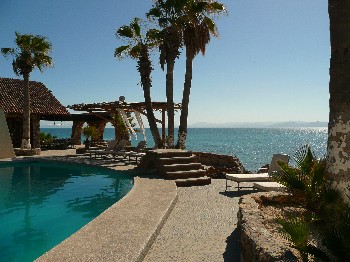
We continued our walk to the beach past the hotel, and I was delighted to find a much better selection of shells, so we both collected shells on our long walk back to the dinghy.
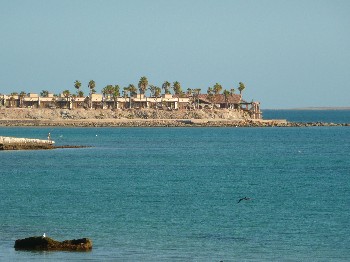
View of the hotel at Punta Chivato.
Garett: After about four hours we returned tired after our very long walk. We settled down for dinner and listened to the evening weather and they talked again about another front coming up tonight with winds from the southwest. The bay at Punta Chivato is wide opened to the southwest so we might have to move.
Sure enough, just as we were finishing dinner all of sudden the wind came up at 20 knots from the south. We had to move right away as the waves quickly built up. Within 10 minutes we had the dinghy on deck and the anchor up and motored into the waves. Our plan was to motor six miles south to the far shore where we would find protection from the waves.
It was a little hairy as we were now motoring into 2-3 foot waves and the wind was howling on this unfamiliar coast in the pitch dark. At about 11 p.m. we finally made our way to 1/4 mile from the shore with the radar and settled down for a sleep but it was still a little bouncy.
Saturday November 24, 2007
Garett: We woke up early and headed to the little city of Mulege, now only five miles away as we wanted to go up the river to the protected anchorage and you have to enter at high tide as there is not very much water at the entrance or in the mouth of the river.
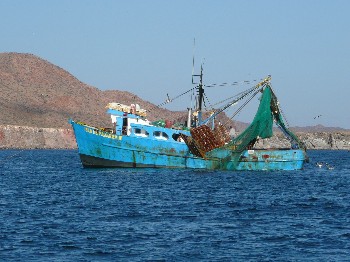
A typical example of a well-worn, unpampered,
hardworking commercial fishboat in Mexico.
In the river at Mulege, we anchored safely in just about four feet of water and immediately rowed about 50 feet to shore to walk into town.
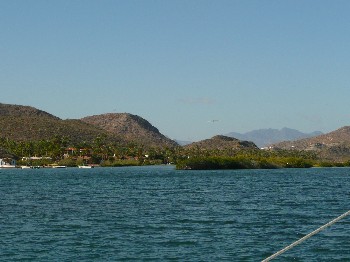
Our anchorage in the mouth of the small river at Mulege,
one of the few rivers on the Baja side.
That is why everything is so green!
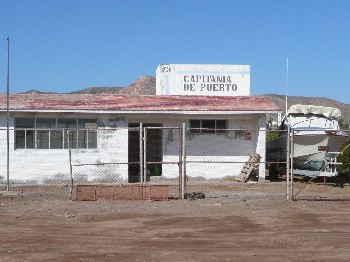
The offices of the Port Captains are not really
being used anymore, now that there is only one
check-in fee paid at the first town you enter in
Mexico at Ensenada.
The guide books said that the town is only a one mile walk. It turned out is almost four miles and so by the time we trudged into town it was lunch time. We had some fish and chips, bought some groceries and Carllie bought some very nice rugs and blankets, already planning for our new Mexico decor when we get home.
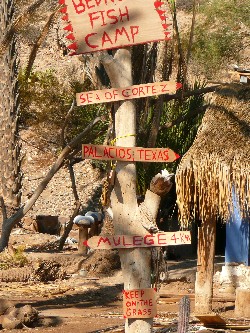
Humorous signs posted on private property on the
long walk to Mulege. Notice the "Keep on the grass"
sign at the bottom!
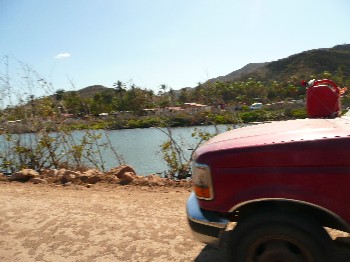
This is an interesting picture I caught of this
truck as he roared by us on the road. He has
an extra gas tank on the hood of his pickup
which is draining into his main tank.
A common occurrence in rural mexico
where you need to extend the range
of your vehicle.
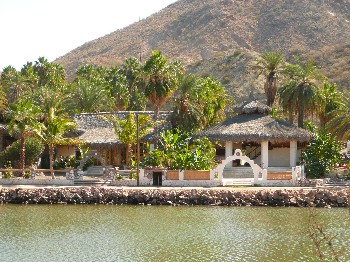
As we walked the four miles up the river to
the town of Mulege we came across many
Gringo vacation homes.
Though they looked good, many of them had been flooded
last year when hurricane John dumped 10 inches
of rain and the river overflowed its banks.
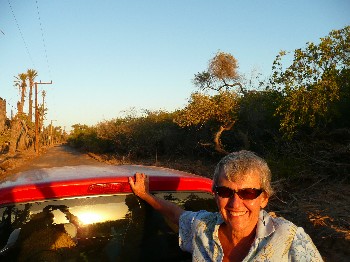
On the ride back we hitched a ride
in the back of a pickup over the
bumpy roads
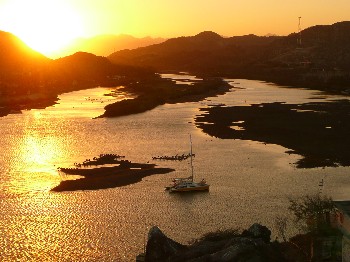
Here is the view form the lighthouse of Light Wave
in the river estuary at Mulege, anchored in about
three feet of water with sand banks all around
when the river was at low tide at sunset.
Carllie: While I waited for Garett to return from his hike up to the lighthouse, I met this really friendly fellow, Luis Garca, who has lived in Mulege near our river anchorage for a couple of years. He speaks fluent English and is a very talented saxophone player, having played with Louis Armstrong and Count Bassie (sp?) in his history. He still plays gigs in the U.S. and Mexico, and will soon be travelling to Mazatlan for a few months to play.
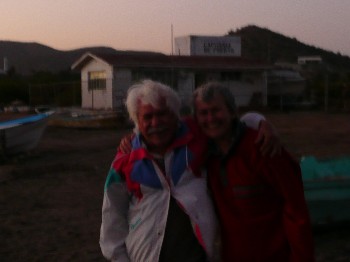
It is easy to make friends with the Mexican
people, but it helps with they can speak
English!
Sunday November 25, 2007
As there was a nice north winds we decided to skip Bahia Concepcion, where we had spent a couple of nights back in April before we crossed the Sea to Guaymas, so we continued to head south.
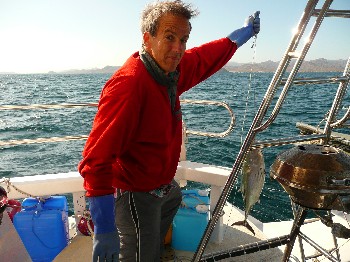
Another tuna but unfortunately it was a
Skipjack tuna with dark meat
instead of a Bonito with white
meat which are the best.
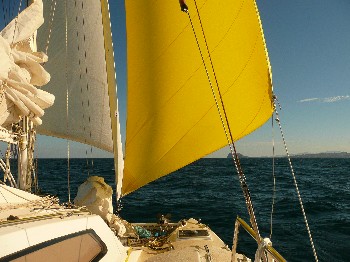
A nice downwind sail to San Juanico.
You can see Punta Pulpito far in the
distance to the south about 15 miles away.
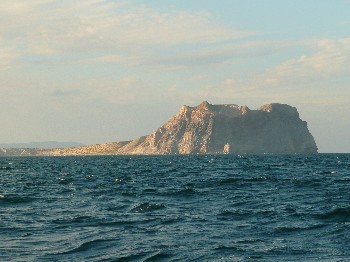
Now just south of Punta Pulpito which
we decided
to skip as the swell was wrapping into the
anchorage. As we passed we radioed friends Cindy
and Tim on Masquerade who we saw anchored there,
and they confirmed it was very rolly and uncomfortable.
We just managed to sneak into Bahia San Juanico with about 10 minutes of usable light and they were about 10 boats inside. We snaked our way through them to a very shallow and protected spot off the beach in only 5 feet of water, very near where we had anchored back in April on our way north to Guaymas.
Monday November 26, 2007
Carllie: It was great to be anchored again in beautiful Bahia San Juanico, with its amazing views through spectacular rock formations. It was also nice to be joined by about ten other boats in the anchorage and feel that camaraderie, even though we did not get a chance to talk to everyone. Garett quickly jumped into the water for a snorkeling reconnoiter of the nearby rocks looking for susceptible fish.
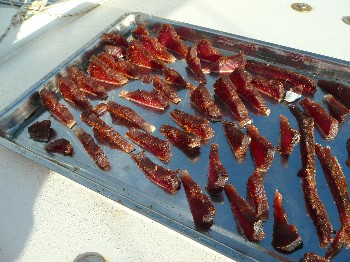
Garett insisted on making jerky out of that awful
Skipjack Tuna, and once he had dried it he ate
every last bit. He was welcome to it!
Garett: This stuff is really good!!
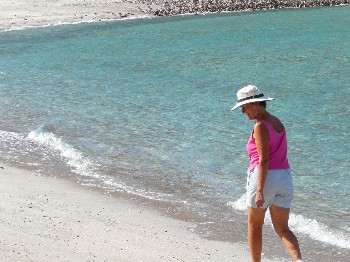
Beautiful clear water at Bahia San Juanico.
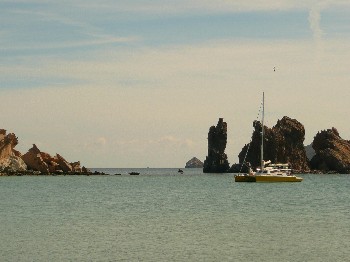
Anchored at spectacular Bahia San Juanico.
Tuesday November 27, 2007
The day started with a beautiful sunrise due to the increasing cloud cover because of a storm system to the west. This would begin a long period of four days of clouds, finishing off with wind and rain on Friday.
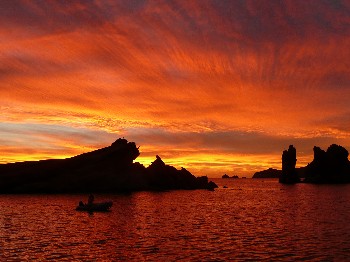
Clouds provide a spectacular sunrise at San Juanico
but foretell rain, rain and more rain!
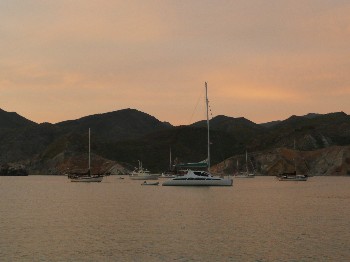
Boats hunkered down for a little gloomy weather but
not wind at San Juanico.
Wednesday November 28, 2007
Carllie: We enjoyed a nice long walk on shore today, as I had to stretch my legs. My left knee is still bothering me so rather than run I have to go for long walks with the hope of keeping in some type of shape, even though a slightly fatter shape than would be possible with more vigorous exercise!
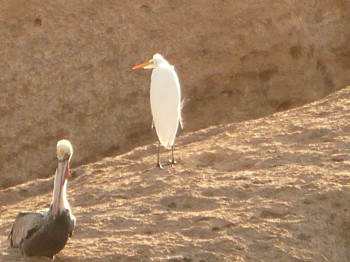
White Heron and White Pelican at San Juanico.
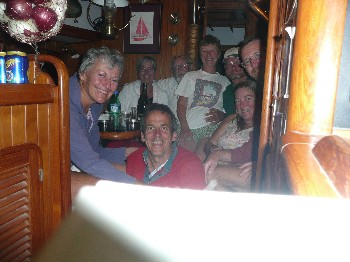
Cindy and Tim (on the right) invited us and a few other
cruising couples to Masquerade for snacks in the
late afternoon, and we stayed until dark talking with
new friends.
Thursday November 29, 2007
We listened to the morning weather and they were predicting south winds of up to 40 knots by Friday. Though there is some protection in the south end of Bahia San Juanico we thought it would be best to head south 35 miles to Puerto Escondido, about 10 miles south of the small coastal city of Loreto.
The sail down today felt like we were back in B.C. in Desolation Sound.
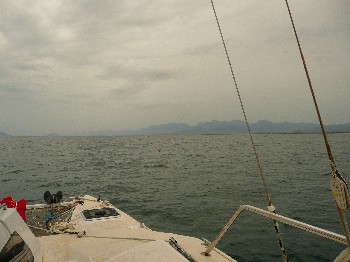
We kept warm with our snug Polartec jackets and our socks.
What a switch!
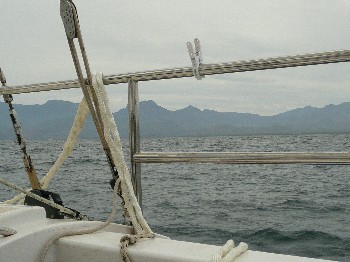
We already miss warm sunshine! How will we
cope with the rainy winters in Vancouver
when we return next year?
While nestled in at Bahia San Juanico, Garett had finally attached the equipment required to operate our new-used Aquair water generator (i.e., generates electricity). This was our first chance to try it out. We towed the big sturdy steel propeller on a sturdy rope about hundred feet behind the boat. The propeller turns in the water and generates electricity inside the gizmo pictured below, which is then transmitted into the boat battery. In this winter season with the sun so low in the sky and only about nine hours of sun daily, some sort of addition to one’s solar power in a must. This method works well if we are traveling between anchorages, but is no help at anchor, when we have to run our motor to keep the battery topped up.
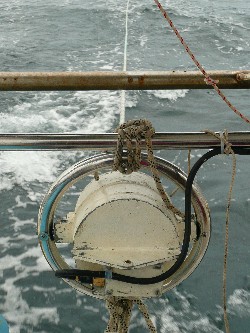
We finally rigged up our towed water generator.
The generator part is tied it up to the aft rail and a 100 foot
line drags behind the boat with a propeller at the end.
As you motor or sail at 5 knots, it the propeller
turns the line which turns the generator
and gives you 4 amps at 12 volts.
We will use this when we cross to Hawaii.
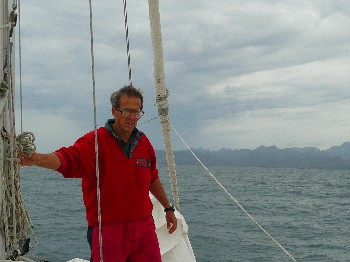
Approaching Escondido with storm
suits on in the drizzle
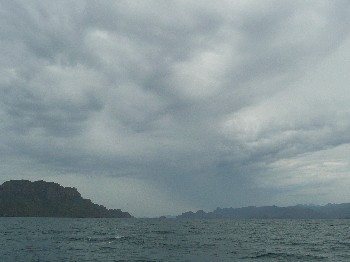
Mean looking cloud formations– a sign
of the bad weather to come.
Carllie: We reached Puerto Escondido in plenty of time, and found a spot in what is a called "The Ellipse," a tiny man-made harbor that is part of an uncompleted development project started in 1985. The project came to an abrupt halt when the Mexican government changed the rules on the French company had already invested millions in the infrastructure of the place. There are streets ashore all ready with power, water and street lights, and this bay is surrounded like an amphitheater by concrete. Safely at anchor, we are now ready for whatever happens with the wind tomorrow.
Friday November 30, 2007
Carllie: As predicted, the wind came up in a big way from the south. And it rained like the Pacific Northwest in the wintertime (right now!). We felt right at home, but eventually grew tired of the limitations imposed by rain and the mess it makes on the cabin and hull floors.
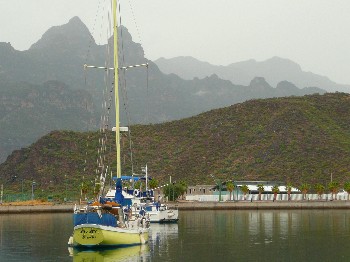
The majestic mountains surrounding Puerto Escondido.
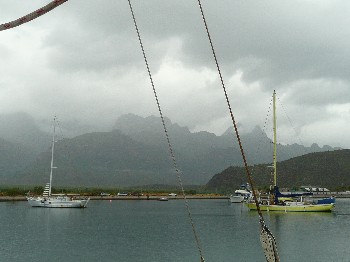
Storm clouds gather to give us a drenching..
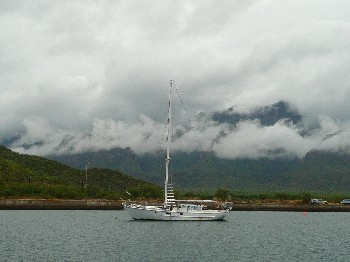
Where is that hot Mexican sun???